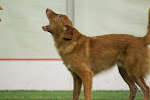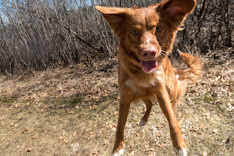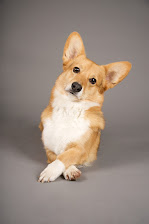Vito in 2012
The Toller's review of the past year.
Anxiety:
Vito had just started seeing a behaviorist about his anxiety issues and had started a new drug last November. We also decided to decrease his Prozac and hope that his separation anxiety wouldn't come back. Unfortunately it wasn't long before it was very evident that Vito needed the much higher dosage. Even after the increase it took a long time for Vito to be OK with being left alone again and it seems as though he will always need a regular schedule of 1-2 short absences per week before he can be left for a long, 5hr, time.
His car anxiety has been a bumpy road. It's been a year and a half since it came out of the blue and decided to stay. Clonidine was started at the initial behavioral appointment and we saw immediate improvement. Unfortunately it seemed as though Vito was developing a tolerance for it and started progressively building back up to full attacks. In July of this past year we had a recheck with the behaviorist and added in Diazepam (Valium) to his list of drugs. His anxiety immediately shot down and Vito started to even close his eyes in the car, but then it came back up again to low levels. After a few months and an increase in the dosage, Vito finally seems to be on a stable track.
As for his general anxiety, Vito had actually gone weeks without having a vocal reaction to people. The move to a new cubicle at work helped to decrease the stimulation a lot and he has been sleeping a ton even when I'm not at my desk (which is often). He had a very rough week the last week at work when I was hardly ever at my desk (17 puppies, ahh!!) but I am hoping our return will be back to normal. Vito still gets overstimulated easily and it can spill into anxiety but since it typically only happens at gatherings that aren't dog trials, it's not a regular concern.
Agility:
 The year started out a bit rough as I tried to figure out ways to keep Vito connected with me warming up and walking into the ring. With advice from Loretta Mueller and Silvia Trkman's Ready, Steady, Go dvd, I worked hard on finding that magical routine. I found his favorite trick was a reverse chest vault and played with that before going into the ring. I finally taught Vito to bark/scream on cue and encouraged it on every start line in practice and trials. It took a long time and when June hit I felt it was all for nothing. I was able to keep Vito focused on me instead of looking at people to stare at, but his intensity in warming up and on the course was still way down. But in July it finally started to click and in the few trials since then I've never been prouder to have the obnoxious screaming dog at the start line. Vito even started to run a bit on courses that didn't have the contact obstacles in them and we finally moved out of novice jumpers! I now have high hopes that Vito will continue to enjoy competing in agility with me. Our last trial was in October but we have a USDAA trial next week.
The year started out a bit rough as I tried to figure out ways to keep Vito connected with me warming up and walking into the ring. With advice from Loretta Mueller and Silvia Trkman's Ready, Steady, Go dvd, I worked hard on finding that magical routine. I found his favorite trick was a reverse chest vault and played with that before going into the ring. I finally taught Vito to bark/scream on cue and encouraged it on every start line in practice and trials. It took a long time and when June hit I felt it was all for nothing. I was able to keep Vito focused on me instead of looking at people to stare at, but his intensity in warming up and on the course was still way down. But in July it finally started to click and in the few trials since then I've never been prouder to have the obnoxious screaming dog at the start line. Vito even started to run a bit on courses that didn't have the contact obstacles in them and we finally moved out of novice jumpers! I now have high hopes that Vito will continue to enjoy competing in agility with me. Our last trial was in October but we have a USDAA trial next week.Training wise, my focus has been on 4 areas.
1. Rewarding weave poles a lot more since those tend to suffer the most when Vito is running slower.
2. Powering out of wraps. Vito gets sticky on me on turns and has a hard time going back to extension running and obstacle focus. When I remember to practice, I've been working on tight wraps and then chasing after me/a thrown toy.
3. Stopped dogwalk! For now, I've given up on my inability to practice turns after Vito's running dogwalk and added in a stopped option. We started our training in August and for the most part the stop is fully trained. I still have to do lots of release proofing but the actual stop vs run part is good.
I am extremely happy with this decision for us. Either full extension, or full collection, no more in between stuff for Vito. I've yet to cue a stop in a trial but I'm guessing I won't be using it that often.
4. Trying to figure out how to keep Vito more obstacle focused instead of being so sticky on me and pulling off jumps. Vito does very well and can even do distance quite nicely but he does not like it if I have to send him and then go.
Obedience:
Vito is still in a semi-retired state. After a great private lesson with Nancy Little, Vito and I have worked extensively on ring entrances and long waits in heel position. We did a few days of CDSP obedience and a day of APDT rally this past year solely because of the ability to reward in the ring at those venues. I learned that only 1 run per day is plenty for Vito; the 2nd run was always too much although I didn't try a 2nd day of trialing to see how that would go. Vito earned his CDX-C this past year with scores in the mid 190's. My absolute favorite run of his was in July when Vito did one run of APDT lv3. It started out rough with Vito glancing everywhere once I stepped into the ring, but after the first 3 seconds of heeling Vito decided everything was OK and he was happy to play with me!
In October I thought we would try our return to the AKC ring, in rally of course. It started out rough with Vito again needing to check out the environment as we walked in. Our ring entrances/setups seemed to help but unfortunately the first sign was a moving down walk around and it was too much for Vito. Perhaps if it was later in the course he would have had more of a rhythm going and been ok with it but so early on it was a no-go. On the positive side, I was able to transform into complete no-care mode and ran Vito around the rest of the course. It worked and Vito finished the rally course forging, bumping, and prancing :)
There will be another CDSP trial in January that I am planning on entering Vito in Open again, but I guess we will hold off on more AKC for awhile.
Disc:
His favorite sport! Vito was able to show off our work on impulse control by his ability to not only walk onto the field without screaming and punching but to also make eye contact with me when holding a disc! We were starting to master leg vaults and reverse chest vaults; 2 things that dictated where Vito took off for the disc. In all other tosses of the frisbee, Vito still was a maniac and leapt from directly underneath the disc and spiraled.
In May we attended another Pawsitive Vybe seminar in hopes that Ron and Apryl could help me to keep Vito safe. They laid an extensive plan involving set point drills, cavalettis, and other things to get him to collect sooner. Many dogs have a similar problem to Vito, but in fixing the degree of severity that Vito was exhibiting we were in new territory. I was a guinea pig and one inexperienced in the world of disc. After a terrifying accident at a competition in June where I purposefully tried to keep all tosses low to the ground to eliminate his take off decisions, Vito entered a state of semi-retirement. We worked on our set point drills but saw little improvement without the equipment. Although with disc being 3rd on our list of priorities I can't say that I put full effort into the plan. In August Vito entered full retirement and at this point I don't have any hope of pulling him out.
Tricks:
Off and on work with the following tricks:
- Foot stall. Been wanting this for a long time but it's SO hard for Vito. We went back to 4ft on a small book but then had to shape Vito to step on it front feet first, THEN back feet. Vito prefers to get the back feet on and then back up the front feet and I think that's part of the issue with the foot stall. Then upside down trash cans were mastered and now we're to the point where he'll jump on Adam's feet as Adam likes on his stomach, feet up. I'm still having to help balance Vito initially.
- Itchy. I love this trick! Vito learned how to scratch his ear with his back foot. Shaped off course, since I don't capture :) Not fully mastered, like all our tricks.
- Crawling leg weaves. Vito crawls as he weaves forward through my legs. Not fully a new trick as he already knew crawl and already knew leg weaves. It's not a smooth trick yet as I still have to bend over and point to keep Vito from standing up.
- Jump into my arms- from the SIDE. Had to reteach Vito's jump up to me trick as the previous version was taught from the front. Even as a puppy this was wiggly and scarey! My real reason to change it though was because Vito would get confused with the reverse chest vault he learned last year and would no longer want to be caught. Now it's more clear to him what behavior I'm asking for.
- Moon. I'm working with Vito on moving from a down to a bow so it looks like he's mooning the audience :) Essentially it's just his "tada" cue proofed from a new position. It's actually been quite hard!
- Scratch board. Our most useful trick! Vito files his own front nails on a board now. Still haven't been able to shape the back feet into any scratching motion though; all I'm getting is marching of the back feet.




.jpg)







